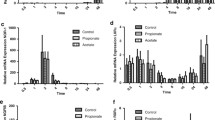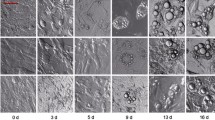Abstract
Four sets of experiments were conducted to examine the influence of conjugated linoleic acid (CLA) isomers during proliferation and differentiation of cultures of 3T3-L1 preadipocytes using physiological culturing conditions. Cultures treated with either albumin [bovine serum albumin (BSA) vehicle] or linoleic acid (LA) served as controls. For the proliferation study (Expt. 1), cells were cultured in media containing a crude mixture of CLA isomers or pure LA at 0, 10, 50, or 200 μM for 4 d. Preadipocyte proliferation (cell number, 3H-thymidine incorporation into DNA) decreased as the level of CLA increased in the cultures. In contrast, LA had no impact on DNA synthesis. In Experiment 2a, postconfluent cultures were grown in media containing a crude mixture of CLA isomers or LA at 0, 10, 50, or 200 μM for the next 6 d. Postconfluent cultures supplemented with 50–200 μM CLA had less triglyceride (TG) and were smaller in size than cultures supplemented with similar amounts of LA. In Experiment 2b, postconfluent cultures supplemented with 200 μM of a crude mixture of CLA isomers or LA were harvested on days 1, 3, 6, or 9. Differences in TG content of cultures supplemented with 200 μM CLA compared to control and LA-supplemented cultures became apparent after 3 d of culture. Experiments 3a and 3b examined whether the fatty acid vehicle (BSA vs. ethanol) or the vitamin E status (±0.2 mM α-tocopherol) of the cultures altered CLA’s impact on preadipocyte TG content. In Experiment 3a, ethanol-treated cultures had more TG than non-ethanol-treated cultures regardless of the fatty acid treatment. In Experiment 3b, cultures treated with 100 μM of either a crude mixture of CLA or the trans-10, cis-12 CLA isomer without supplemental vitamin E for 6 d had less TG than CLA-treated cultures containing vitamin E. In Experiment 4, postconfluent cultures were grown in media containing 100 μM LA or either a crude mixture of CLA isomers or the trans-10, cis-12 CLA isomer for 24–96 h to assess CLA’s influence on the cell cycle and indices of apoptosis. Cultures treated with 100 μM CLA for 24–96 h had more apoptotic cells than BSA- or LA-treated cultures. Furthermore, cultures treated for 48 h with CLA had fewer cells in the S-phase than control cultures. The effects of the trans-10,cis-12 CLA isomer were more pronounced than those of the crude mixture of CLA isomers. These data suggest that CLA may exert its antiobesity effects by inhibiting proliferation, attenuating TG content, and/or inducing apoptosis in (pre)adipocytes.
Similar content being viewed by others
Abbreviations
- AA:
-
arachidonic acid
- ANOVA:
-
analysis of variance
- BCA:
-
bicinchoninic acid
- BCS:
-
bovine calf serum
- BSA:
-
bovine serum albumin
- CLA:
-
conjugated linoleic acid
- DAG:
-
diacylglycerol
- DMEM:
-
Dulbecco’s modified Eagle’s medium
- DMSO:
-
dimethyl sulfoxide
- EC50 :
-
effective concentration that reduces activity by 50%
- FBS:
-
fetal bovine serum
- HBSS:
-
Hank’s balanced salt solution
- HMDS:
-
hexamethyldisilazane
- LA:
-
linoleic acid
- LDH:
-
lactate dehydrogenase
- LPL:
-
lipoprotein lipase
- PBS:
-
phosphate-buffered saline
- PI:
-
propidium iodide
- PPAR-γ2:
-
peroxisome proliferating activated receptor-γ2
- SEM:
-
scanning electron microscopy
- TG:
-
triglyceride
References
Belury, M. (1995) Conjugated Dienoic Linoleate: A Polyunsaturated Fatty Acid with Unique Chemoprotective Properties, Nutr. Rev. 53, 83–89.
Lee, K., Kritchevsky, D., and Pariza, M. (1994) Conjugated Linoleic Acid and Atherosclerosis in Rabbits, Atherosclerosis 108, 19–25.
Nicolosi, R., Rogers, E., Kritchevsky, D., Scimeca, J., and Huth, P. (1997) Dietary Conjugated Linoleic Acid Reduces Plasma Lipoproteins and Early Aortic Atherosclerosis in Hypercholesterolemic Hamsters, Artery 22, 266–277.
Houseknecht, K., Heuvel, J., Moya-Camarena, S., Portocarrero, C., Peck, L., Nickel, K., and Belury, M. (1998) Dietary Conjugated Linoleic Acid Normalizes Impaired Glucose Tolerance in Zucker Diabetic Fatty fa/fa Rat, Biochem. Biophys. Res. Commun. 244, 678–682.
West, D., Delany, J., Camet, P., Blohm, F., Truett, A., and Scimeca, J. (1998) Effects of Conjugated Linoleic Acid on Body Fat and Energy Metabolism in the Mouse, Am. J. Physiol. 275, R667-R672.
Park, Y., Albright, K., Liu, W., Storkson, J., Cook, M., and Pariza, M. (1997) Effect of Conjugated Linoleic Acid on Body Composition in Mice, Lipids 32, 853–858.
Park, Y., Storkson, J., Albright, K., Liu, W., and Pariza, M. (1999) Evidence that trans-10, cis-12 Isomer of Conjugated Linoleic Acid Induces Body Composition Changes in Mice, Lipids 34, 235–241.
Park, Y., Albright, K., Storkson, J., Liu, W., Cook, M., and Pariza, M. (1999) Changes in Body Composition in Mice During Feeding and Withdrawal of Conjugated Linoleic Acid, Lipids 33, 243–248.
Park, Y., McGuire, M., Behr, R., McGuire, M., Evans, M., and Schultz, T. (1999) High-Fat Dairy Product Consumption Increases Δ-9c,11t−18∶2 (rumenic acid) and Total Lipid Concentration of Human Milk, Lipids 34, 543–549.
DeLany, J., Blohm, F., Truett, A., Scimeca, J., and West, D. (1999) Conjugated Linoleic Acid Rapidly Reduces Body Fat Content in Mice Without Affecting Energy Intake, Am. J. Physiol. 276, R1172-R1179.
Cook, M., Jerome, D., Crenshaw, T., Buege, P., Pariza, M., Albright, K., Schmidt, S., Scimeca, J., Lotgren, P., and Hentges, E. (1999) Feeding Conjugated Linoleic Acid Improves Feed Efficiency and Reduces Carcass Fat in Pigs, 27th Steenbock Symposium, Adipocyte Biology and Hormone Signaling Symposium, June 7–9, p. 67.
Ostrowska, E., Muralitharan, M., Cross, R., Bauman, D., and Dunshea, F. (1999) Dietary Conjugated Linoleic Acids Increase Lean Tissue and Decrease Fat Deposition in Growing Pigs, J. Nutr. 129, 2037–2042.
Satory, D., and Smith, S. (1999) Conjugated Linoleic Acid Inhibits Proliferation but Stimulates Lipid Filling of Murine 3T3-L1 Preadipocytes, J. Nutr. 129, 92–97.
Brodie, A., Manning, V., Ferguson, K., Jewell, D., and Hu, C.Y. (1999) Conjugated Linoleic Acid Inhibits Differentiation of Pre-and Post-Confluent 3T3-L1 Preadipocytes but Inhibits Cell Proliferation Only in Pre-confluent Cells, J. Nutr. 129, 602–606.
MacDougald, O., and Lane, D. (1995) Transcriptional Regulation of Gene Expression During Adipocyte Differentiation, Annu. Rev. Biochem. 64, 345–373.
McIntosh, M., Lea-Currie, R., Geigerman, C., and Pasevouros, L. (1999) Dehydroepiandrosterone Alters the Growth of Stromal-Vascular Cells from Human Adipose Tissue, Int. J. Obesity 23, 595–602.
Loo, D., and Rillema, J. (1998) Measurement of Cell Death, in Methods in Cell Biology, Vol. 57, pp. 251–263, Academic Press, New York.
Glascott, P., Gilfor, E., and Farber, J. (1992) Effects of Vitamin E on the Killing of Cultured Hepatocyte by tert-Butyl Hydroperoxide, Mol. Pharmacol. 41, 1055–1102.
Magun, R., Boone, D., Tsang, B., and Sorisky, A. (1998) The Effect of Adipocyte Differentiation on the Capacity of 3T3-L1 Cells to Undergo Apoptosis in Response to Growth Factor Deprivation, Int. J. Obes. 22, 567–571.
Ip, C., Banni, S., Angioni, E., Carta, G., McGinley, J., Thompson, H., Barbano, D., and Bauman, D. (1999). Conjugated Linoleic Acid-Enriched Butter Fat Alters Mammary Gland Morphogenesis and Reduces Cancer Risk in Rats, J. Nutr. 129, 2135–2142.
Ip, M., Masso-Welch, P., Shoemaker, S., Shea-Eaton, W., and Ip, C. (1999). Conjugated Linoleic Acid Inhibits Proliferation and Induces Apoptosis of Normal Rat Mammary Epithelial Cells in Primary Culture, Exp. Cell Res. 250, 22–34.
Shultz, T., Chew, B., and Seaman, W. (1992) Differential Stimulatory and Inhibitory Responses of Human MCF-7 Breast Cancer Cells to Linoleic Acid and Conjugated Linoleic Acid in Culture, Anticancer Res. 12, 2143–2146.
Chouinard, P., Corneau, L., Bardano, D., Metzeger, L., and Bauman, D. (1999) Conjugated Linoleic Acids Alter Milk Fatty Acid Composition and Inhibit Milk Fat Secretion in Dairy Cows, J. Nutr. 129, 1579–1584.
Ha, Y., Storkson, J., and Pariza, M. (1990) Inhibition of Benzopyrene-Induced Mouse Forestomach Neoplasia by Conjugated Dienoic Derivative of Linoleic Acid, Cancer Res. 50, 1097–1101.
Ip, C., Chin, S., Scimeca, J. and Pariza, M. (1991) Mammary Cancer Prevention by Conjugated Dienoic Derivative of Linoleic Acid, Cancer Res. 51, 6118–6124.
Graber, R., Sumida, C., and Nunez, J. (1994) Fatty Acids and Cell Signal Transduction, J. Lipid Mediators Cell Signalling 9, 91–116.
O’Shea, M., Stanton, C., and Devery, R. (1999) Antioxidant Enzyme Defense Responses of Human MCF-7 and SW480 Cancer Cells to Conjugated Linoleic Acid, Anticancer Res. 19, 1953–1960.
Schonberg, S., and Krokan, H. (1995) The Inhibitory Effect of Conjugated Dienoic Derivatives (CLA) of Linoleic Acid on the Growth of Human Tumor Cell Lines Is in Part Due to Increased Lipid Peroxidation, Anticancer Res. 15, 1241–1246.
Cunningham, D., Harrison, L., and Schultz, T. (1997) Proliferative Responses of Normal Human Mammary and MCF-7 Breast Cancer Cells to Linoleic Acid, Conjugated Linoleic Acid and Eicosanoid Synthesis Inhibitors in Culture, Anticancer Res. 17, 197–204.
Bielski, B., Arudi, R., and Sutherland, M. (1983) A Study of the Reactivity of H2O2 with Unsaturated Fatty Acids, J. Biol. Chem. 258, 4759–4761.
Author information
Authors and Affiliations
Corresponding author
About this article
Cite this article
Evans, M., Geigerman, C., Cook, J. et al. Conjugated linoleic acid suppresses triglyceride accumulation and induces apoptosis in 3T3-L1 preadipocytes. Lipids 35, 899–910 (2000). https://doi.org/10.1007/S11745-000-0599-6
Received:
Revised:
Accepted:
Issue Date:
DOI: https://doi.org/10.1007/S11745-000-0599-6




